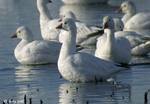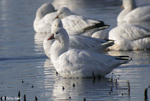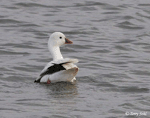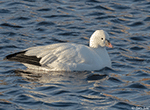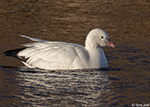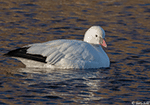| Length: 20 to 25 inches | Wingspan: 48 to 54 inches | Seasonality: Migrant |
| ID Keys: White overall, stubby dark pink bill with warty blue base, lack of "grinning patch" seen on Snow Goose, smaller than Snow Goose. | ||
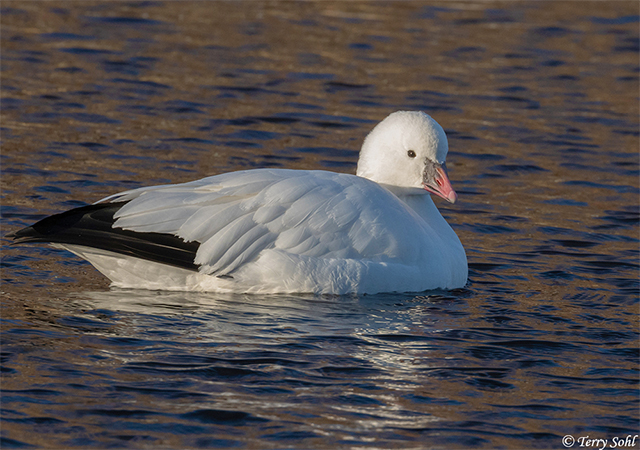 The Ross's Goose can
sometimes be found with its close cousin, the Snow
Goose, as they migrate through the state. While quite similar, Ross's
Geese can be differentiated from the Snow Goose by
their smaller size, shorter stubby bill with a warty blue base, lack of a
"grinning patch" on the beak, and shorter neck. They were once
considered extremely rare, but have been increasing in numbers in recent
decades. They are the smallest goose normally found in North America.
The Ross's Goose can
sometimes be found with its close cousin, the Snow
Goose, as they migrate through the state. While quite similar, Ross's
Geese can be differentiated from the Snow Goose by
their smaller size, shorter stubby bill with a warty blue base, lack of a
"grinning patch" on the beak, and shorter neck. They were once
considered extremely rare, but have been increasing in numbers in recent
decades. They are the smallest goose normally found in North America.
Habitat:
Breeds on the Arctic Tundra, primarily in wetland areas of mixed grass and brushy thickets. In migration and in winter, they can be found in a variety of aquatic environments, as well as agricultural fields where they may feed heavily on waste grain.
Diet:
Primarily feeds on grasses and sedges. Also can feed quite heavily on roots, seeds, and waste grain in farm fields.
Behavior:
Will forage by either walking along the land, or by swimming or wading in shallow water. Gregarious, usually in flocks. In migration in the state, nearly always found in groups of Snow Geese.
Breeding:
Non-breeder in South Dakota. On their normal breeding range in the Arctic, Ross's Geese are colonial nesters, forming loose colonies that may have many hundreds of birds scattered across the landscape. Nests are often built on semi-protected areas such as islands in Arctic lakes and ponds. The nest is built on arctic tundra vegetation, and consists of grasses, mosses, and/or willow stems, lined with down. The female lays 2 to 5 eggs, which she alone incubates. Incubation takes about 3 weeks, after which both parents may tend to and protect the young, with young gathering food on their own.
Song:
Mostly quiet. However they do have a flight call they often give in alarm, and also havee high-pitched keek-keek call, and a lower grunting call.
1Click here to hear the flight call of a Ross's Goose
Migration:
Summers in or near the Arctic Circle. Most winter in central California, but with increasing numbers of the species in recent decades, they have also begun to winter in other locations in the southwestern United States.
Interactive eBird Map:
Click here to access an interactive eBird map of Ross's Goose sightings
Similar Species:
Most likely to be confused with Snow Geese, particularly as the two species are usually found in mixed species groups together. Overall size is one clue, as the Ross's Goose is noticeably smaller if seen side-by-side with Snow Geese. The bill is the other obvious differentiating factor, as Ross's Geese have a shorter, stubbier bill that lacks the dark "grinning patch" characteristic of a Snow Goose. Also note that Ross's Geese are overwhelming found in the white phase, as the "blue phase" that's common in Snow Geese is very rare in Ross's Geese.
Click here for a page of identification tips for Snow and Ross's Goose.
Conservation Status:
Populations declined sharply with hunting pressures in the 19th and early part of the 20th century. However, numbers have rebounding and are increasing in the past few decades. Ross's Geese are found across a very broad geographic range, and are common in parts of that range. The IUCN considers the Ross's Goose to be a species of "Least Concern".
Further Information:
1) Patuxent Bird Identification InfoCenter, Ross's Goose
3) Audubon Guide - Ross's Goose
Photo Information:
November 15th, 2020 - Yankton, South Dakota - Terry Sohl
Additional Photos:
Click on the image chips or text links below for additional, higher-resolution Ross's Goose photos.
Audio File Credits:
1Paul Marvin - December 30th, 2017 - Imperial County, California - Original recording and information available from xeno-canto.
| Click on the range map for a higher-resolution view |
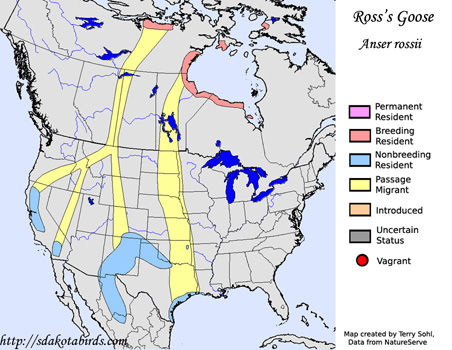 |
| South Dakota Status: Uncommon migrant. Casual in winter. |
Additional Ross's Goose Photos
Click for a higher-resolution version of these photos
